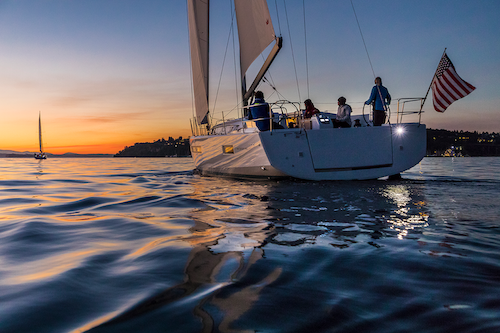There are many reasons why you may find yourself out on the water after dark. You may be night fishing, taking a moonlit romantic cruise or getting back after a dinner that ran long. Night boating is different from day excursions and adds particular challenges. The good news is that you can prepare for most contingencies and after a nighttime outing or two, you’ll be much more comfortable.
10 Tips for Boating at Night
- Slow down, visibility is reduced at night.
- Share the lookout duties.
- Tap into your preparations list.
- Preserve your night vision.
- Don't use headlights or spotlights.
- Look for the red and green.
- Listen, listen, listen.
- Trust your navigation instruments.
- Bring along a towel—for many uses.
- Dock with extra caution.
Explore Boats Perfect for Overnight Cruising
1. Slow down
Visibility is reduced at night. Distances are harder to judge, obstacles are difficult to see, and moisture and temperature changes create distortion. Boats can come out of nowhere and debris and crab pots are nearly invisible on inky black water. Unless there’s a full moon, open water and no traffic, don’t run on plane.
2. Share the lookout duties
The driver has much to do including keeping an eye on gages, checking the chartplotter and actually driving. If you have someone along, keep that second pair of eyes strictly on the horizon with a periodic 360-dgree scan to ensure no one is coming up from behind or at an angle.
3. Tap into your preparations list
Before ever setting out in the dark, you should have refreshed the batteries in your flashlights and headlamps, put binoculars close to the helm and located personal floatation devices (PFDs). You may consider wearing PFDs with an attached strobe light or glow stick in case someone goes overboard.
Learn More: Boat Safety Checklist & Safety Equipment List
4. Preserve your night vision
Dim all the onboard lights including courtesy lights, instrument and chartplotter backlighting and cabin lights. Your night vision can take 20 minutes to adapt back to darkness after a flash of light. Use flashlights with a vision-preserving red filter and check the plotter only when needed because even when dimmed, it will impact your ability to see out of the boat.

5. Don’t use headlights or spotlights
You’re not in a car and the reflective water kills the benefits of bright forward lights. Use docking lights only when arriving at your destination like at a dock or another boat. That’s when spotlights help you see close-up detail like cleats and handholds.
6. Look for the red and green
Running and marker lights are red and green. Entering a harbor in North America, follow the rule: Red, Right, Returning which means keep the red lights to starboard to stay in a safe channel. Consider what a boat looks like under way on the water:
- Red and green lights are forward on either side of the bow and a white light is aft at the stern.
- If you see both red and green, the boat is coming head on.
- If you see white, the boat is ahead of you and/or moving away.
- If in doubt and you see red, stop. That means a boat is crossing your bow and it has the right of way.
Before departing on your voyage, check to make sure your navigation lights are operable so you’re visible to others.
7. Listen
Turn off the stereo and listen. You may hear fog horns, bells or other boats approaching. Use your hearing, which may seem more acute in the dark when you can’t rely on your eyes.
8. Trust your navigation instruments
Your eyes can play tricks on you in the dark so if your chartplotter is trustworthy normally, don’t suddenly decide it must be wrong. If your chartplotter hasn’t been updated or you’re not all that familiar with its use, slow down and approach with caution until you figure out whether your eyes and ears or your electronics are right.
Learn More: How to Navigate a Boat
9. Bring along a towel
A nice beach towel has lots of uses at night. You can drape it over yourself to stay warm and dry, you can toss it over parts of your console to cut down on ambient onboard light, and you can use it wipe a fogged windshield.
10. Dock with extra caution
Again, distances are distorted at night so only approach a dock as fast as you’re willing to hit it. Ask crew not to jump onto a dock but rather step off calmly when the boat is close enough. Double-check everyone’s knots and hitches before leaving the boat unattended in a slip. For more docking tips, be sure to read How to Dock a Boat: Step-by-Step Guide.
Night boating was once described as "riding a giant worm through Disneyland’s Space Mountain"—that’s not an exaggeration. However, if you’re prepared, vigilant and cautious, you’ll find that nighttime excursions can be quite pleasant.
Read Next: Boat Camping: 5 Tips for Sleeping Onboard
You Might Also Like:
- Living on a Boat: Beginner's Guide to Liveaboards
- 5 Tips for Cooking on a Boat
- How to Navigation a Boat
- Safe Boating Guide
- Explore Overnight Cruising Boats


